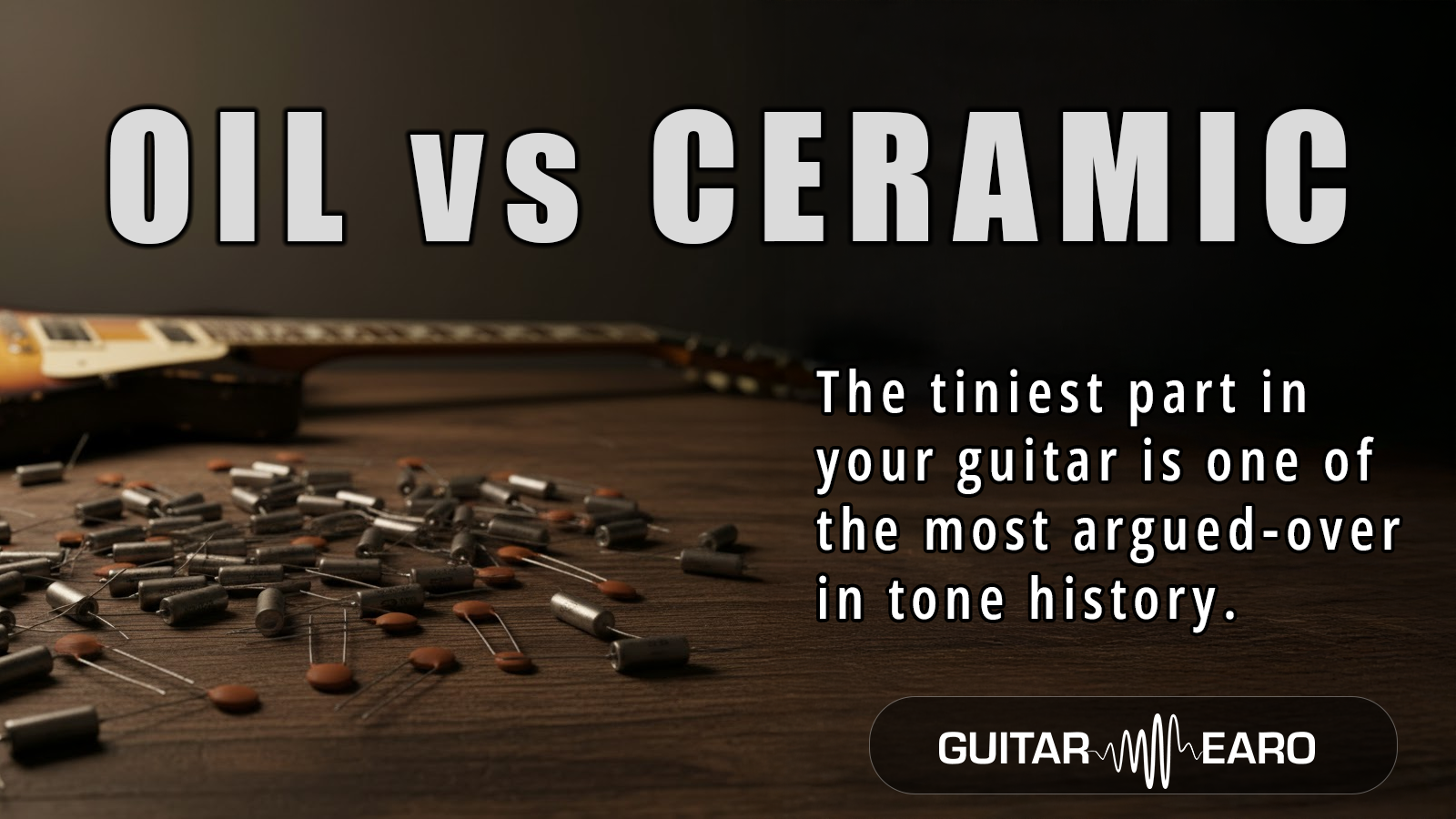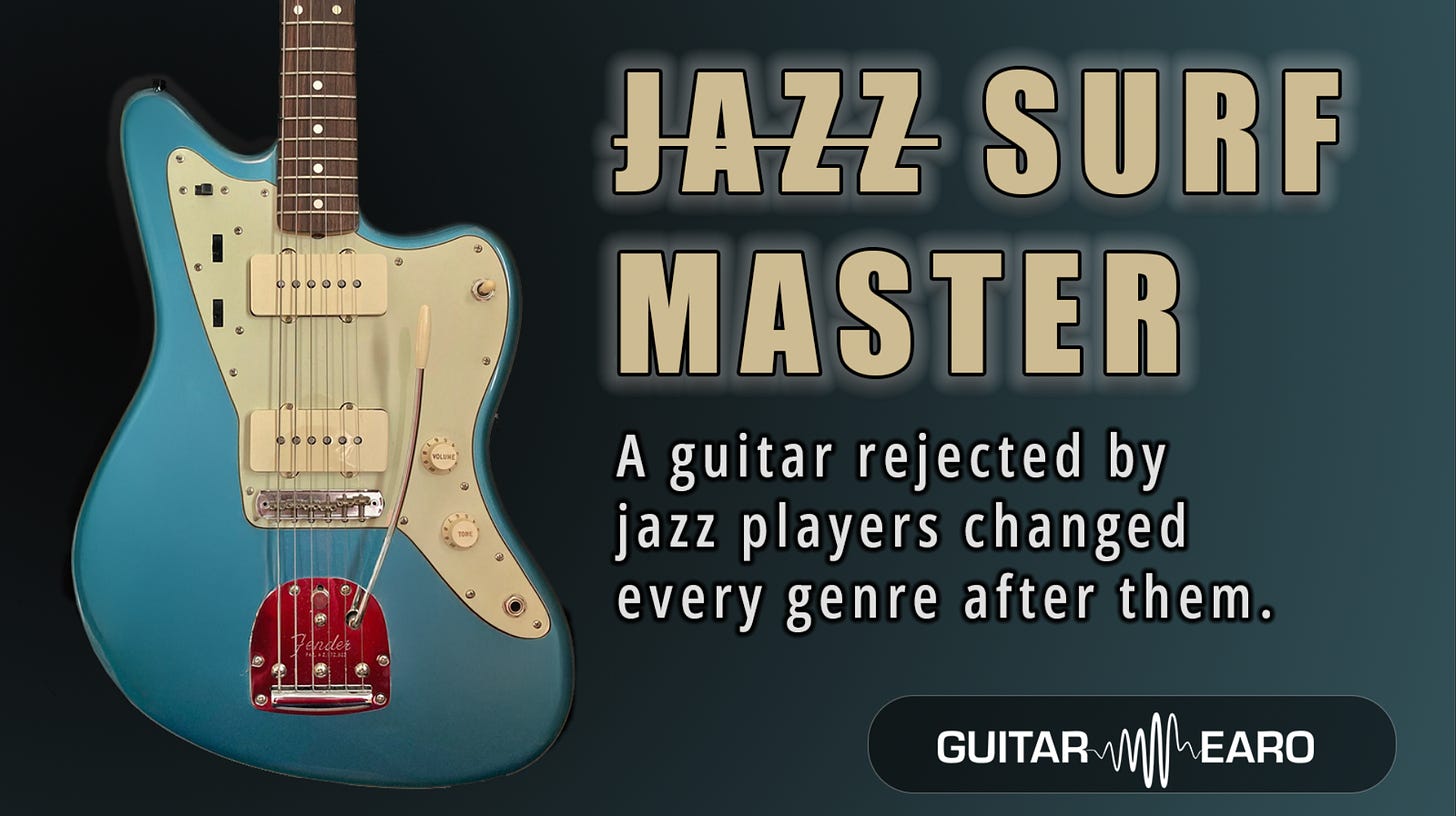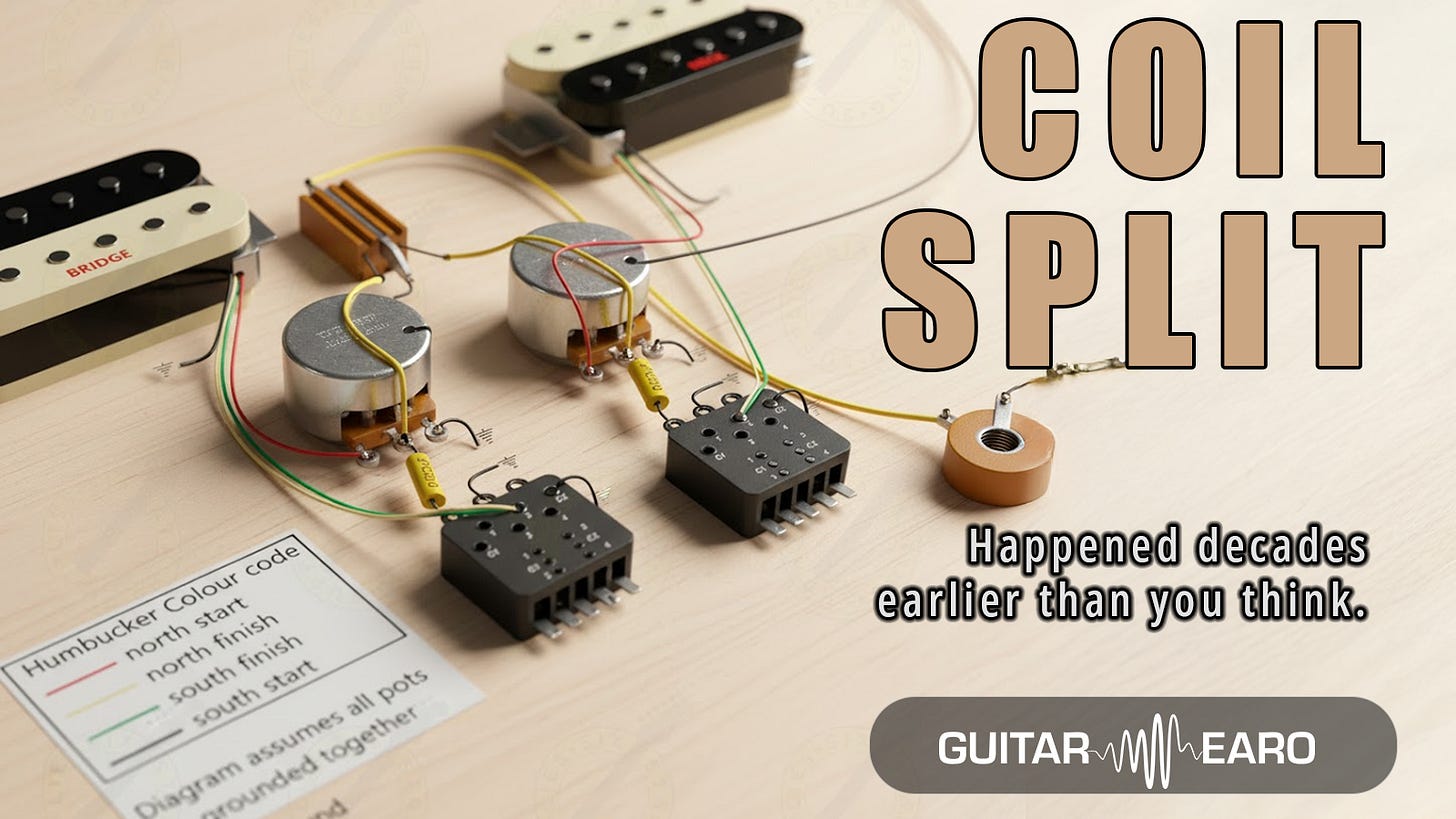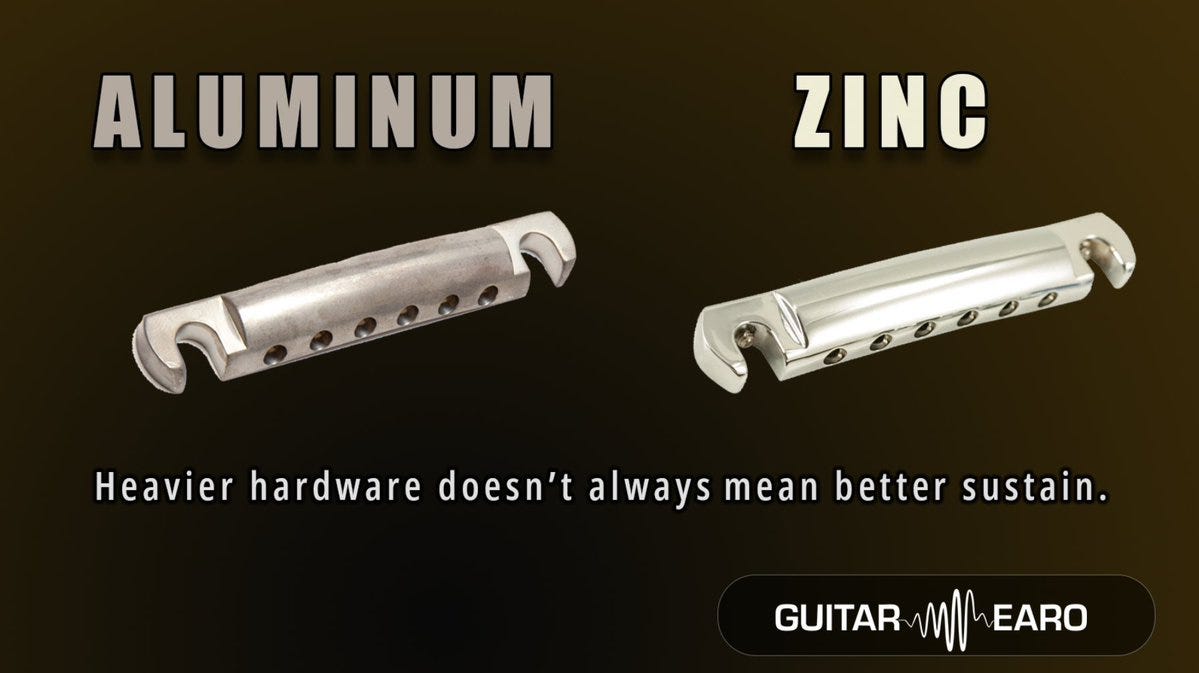Inside almost every electric guitar, hidden under the tone knob, lies a small, silent component that has launched decades of debate among tone purists: the tone capacitor. It’s an unglamorous part, typically a small blob of resin or wax with two wires, but in certain circles, it carries almost mystical significance.
From Gibson’s paper-in-oil “Bumblebee” capacitors of the 1950s to Fender’s humble ceramic disks, this is the story of how one microfarad of electrical storage became a cultural and sonic battleground.
f you love myth-busting tone science like this, you’ll feel at home in the Guitar Earo newsletter: subscribe here before the next article drops.
The role of the tone capacitor
In a passive guitar circuit, your tone control is a low-pass filter: a variable resistor (the tone pot) in series with a capacitor connected to ground. As you roll down the tone knob, high frequencies bleed off, softening the sound.
The cutoff frequency of that filter depends on the product of resistance (R) and capacitance (C):
f_c = \frac{1}{2\pi R C}
In other words, a 0.022 µF capacitor with a 250kΩ pot produces a cutoff around 290 Hz when fully rolled off, meaning everything above that starts getting progressively attenuated.
On paper, the only thing that matters for frequency response is capacitance value, not what the capacitor is made of. A microfarad is a microfarad, whether it’s paper-in-oil, polyester film, or ceramic. Yet, the debate persists because tone isn’t just physics, it’s perceived.
The birth of the Bumblebee
In the 1950s, Gibson used Sprague “Black Beauty” and later “Bumblebee” paper-in-oil capacitors in Les Pauls. These were mil-spec components designed for stability and low dielectric absorption. They used a foil conductor sandwiched with paper soaked in oil as the dielectric.
Fender, meanwhile, went the utilitarian route. Leo Fender’s early Broadcasters, Telecasters, and Stratocasters were fitted with small ceramic disk capacitors: cheap, reliable, and easy to source in bulk.
Thus, two material philosophies were born:
Gibson’s luxurious hi-fi componentry, echoing its archtop and jazz heritage.
Fender’s pragmatic approach, designed for mass production and ruggedness.
No one at the time thought these choices would define decades of argument.
Do materials actually change tone?
Electrically, the dielectric material (paper, ceramic, film, mica, etc.) affects two main non-ideal behaviours:
Leakage current: how much DC “leaks” through when it shouldn’t.
Dielectric absorption (DA): how the material releases stored charge over time.
In a high-impedance circuit like a guitar, these effects are minute but measurable. A paper-in-oil cap tends to have slightly higher leakage than a ceramic cap, especially after decades of aging. That means a small trickle of current can bias the tone pot’s taper, subtly shifting how it rolls off highs.
Ceramic caps, on the other hand, have excellent insulation but higher microphonics and temperature sensitivity. Some claim they can “ring” mechanically under vibration, though at guitar voltages (tens of millivolts), that’s almost academic.
In blind measurements, the difference between a healthy modern 0.022 µF film cap and a 0.022 µF ceramic is typically within ±0.1 dB in the audio band. In perceptual terms, that’s virtually inaudible.
Yet, perception doesn’t always obey math.
The psychoacoustics of expectation
When players replace a dull old ceramic disk with a $50 vintage Bumblebee, they often hear smoother highs, richer mids, or a sweeter taper. But numerous double-blind tests (notably by Dave Hunter, Premier Guitar 2012; and Gibson R&D 2015) show that when the tester doesn’t know which capacitor is in circuit, the ability to identify it drops to random guessing.
Still, expectation bias is powerful. Guitarists are feel-based creatures. A new cap that looks vintage, feels expensive, or carries a brand myth (like “Jensen PIO, same as 1959 Burst!”) changes the player’s emotional state. That alone can alter performance dynamics, pick attack, phrasing, even volume knob use, and thereby tone.
This is what makes the capacitor debate enduring: it’s not just about frequency response. It’s about belief, ritual, and the illusion of control over the most elusive thing in music: feel.
When the tone knob is full up
One of the most contentious claims is that caps affect tone even when the knob is at 10. In theory, the cap is disconnected at that point (the resistance to ground is near infinite), so it shouldn’t matter.
However, in the real world, pots have tolerances, and some leakage or parasitic capacitance can allow minute interaction with the signal. Old PIO caps can show insulation resistance as low as 10 MΩ. In a 1 MΩ volume circuit, that’s not entirely negligible: it can shave a fraction of a decibel from extreme highs.
Again, it’s subtle. But to a guitarist who’s spent hours listening to harmonic overtones decay through a dimed tweed amp, subtle can feel cosmic.
Economics of a myth
The tone-cap industry is now a niche market worth millions. Companies sell “vintage-correct” Bumblebee replicas for over $100 apiece. Boutique harness builders use SoZo, Jupiter, and Luxe caps as selling points. Some Gibson Custom Shop models even ship with “reissue-spec” capacitors.
Ironically, many of these reissues aren’t paper-in-oil at all: they’re polypropylene film caps printed to look vintage. But the aesthetic alone taps into the mythology of 1950s tone purity.
Meanwhile, engineers point out that a modern polyester or polypropylene film capacitor (e.g., Panasonic ECQ series) offers lower distortion, tighter tolerance, and zero leakage… for about 20 pence.
What does the science say?
Controlled measurements using a signal generator, resistive load, and audio interface show negligible differences in frequency response between cap types when values are equal.
However, time-domain tests reveal subtle differences in transient behaviour and phase at very high frequencies (>10 kHz), especially with aged paper caps. These are well above the guitar’s fundamental spectrum but could influence overtones captured by a sensitive amp input.
In other words: measurable, yes; musically meaningful, questionable.
But tone chasing isn’t about objectivity. It’s about curiosity: the same impulse that drives someone to polish frets with micromesh or rewire a Les Paul at midnight just to hear if the world tilts slightly warmer.
The psychology of precision
Why does this debate persist when physics says “it shouldn’t matter”? Because guitar tone culture thrives on rituals of precision.
The same way hi-fi enthusiasts swap silver interconnects.
The same way violinists argue over rosin brands.
The same way drummers claim they can “hear” different bearing edges.
The act of refinement, real or imagined, becomes part of the artistry. Replacing a capacitor isn’t just maintenance; it’s a symbolic tuning of the self to the instrument.
Where it actually matters
If you play with the tone knob rolled down a lot (think jazz players or fuzz-era tones), the capacitor’s taper and Q factor do shape the sound. A smoother cap can make the low-pass roll-off less abrupt, especially in the 2–5 kHz region.
But for most modern players who leave the tone knob wide open, your cable capacitance, pot value, and pickup inductance dwarf any dielectric difference.
So if you want more “warmth,” the easiest fix isn’t a $100 Bumblebee: it’s a shorter cable or lower-capacitance wire.
Conclusion: belief as part of tone
The paper-in-oil vs. ceramic debate is a mirror held up to the entire culture of guitar tone.
It reminds us that obsession, superstition, and science coexist uneasily in the same space.
Does the capacitor material really change the tone?
Not much.
But does the belief that it does change the way we play?
Absolutely.
And maybe that’s why, seventy years later, we still care about what’s hiding under that tone knob.
TL;DR:
The tone cap forms a low-pass filter. Material differences are vanishingly small.
Paper-in-oil = vintage mythos, possible leakage warmth.
Ceramic = cheap, stable, less romantic.
Blind tests: almost no audible difference.
Real differences arise only when tone is rolled down or caps are degraded.
The rest is psychology: and that’s part of the art.
🎸 If this made you rethink what “matters” in guitar tone, join the Guitar Earo newsletter.
Learn the Tone,
Save the Sound.




